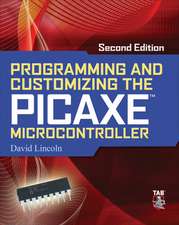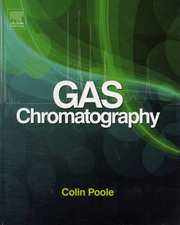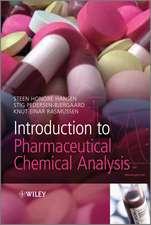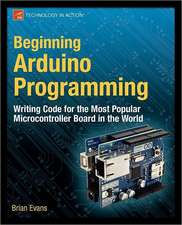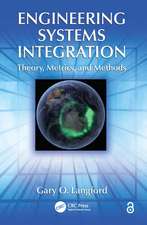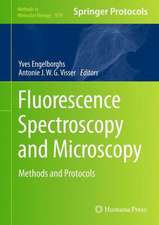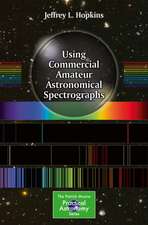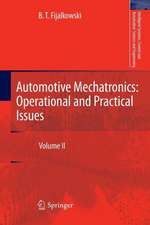Fluorescence Spectroscopy, Imaging and Probes: New Tools in Chemical, Physical and Life Sciences: Springer Series on Fluorescence, cartea 2
Editat de Ruud Kraayenhof, Antonie J.W.G. Visser, Hans C. Gerritsenen Limba Engleză Paperback – 21 oct 2012
| Toate formatele și edițiile | Preț | Express |
|---|---|---|
| Paperback (1) | 395.25 lei 6-8 săpt. | |
| Springer Berlin, Heidelberg – 21 oct 2012 | 395.25 lei 6-8 săpt. | |
| Hardback (1) | 588.51 lei 6-8 săpt. | |
| Springer – 23 iul 2002 | 588.51 lei 6-8 săpt. |
Din seria Springer Series on Fluorescence
-
 Preț: 401.03 lei
Preț: 401.03 lei - 18%
 Preț: 1818.96 lei
Preț: 1818.96 lei - 18%
 Preț: 1216.16 lei
Preț: 1216.16 lei - 18%
 Preț: 1216.78 lei
Preț: 1216.78 lei - 18%
 Preț: 1829.68 lei
Preț: 1829.68 lei - 18%
 Preț: 1225.31 lei
Preț: 1225.31 lei - 18%
 Preț: 2310.76 lei
Preț: 2310.76 lei - 18%
 Preț: 1223.74 lei
Preț: 1223.74 lei - 18%
 Preț: 1225.79 lei
Preț: 1225.79 lei - 18%
 Preț: 1223.25 lei
Preț: 1223.25 lei - 18%
 Preț: 1216.65 lei
Preț: 1216.65 lei - 24%
 Preț: 1711.11 lei
Preț: 1711.11 lei - 18%
 Preț: 950.52 lei
Preț: 950.52 lei - 18%
 Preț: 959.82 lei
Preț: 959.82 lei - 18%
 Preț: 964.71 lei
Preț: 964.71 lei - 18%
 Preț: 1240.93 lei
Preț: 1240.93 lei - 18%
 Preț: 1815.63 lei
Preț: 1815.63 lei - 18%
 Preț: 1821.81 lei
Preț: 1821.81 lei - 18%
 Preț: 1818.79 lei
Preț: 1818.79 lei
Preț: 395.25 lei
Nou
Puncte Express: 593
Preț estimativ în valută:
75.63€ • 78.97$ • 62.45£
75.63€ • 78.97$ • 62.45£
Carte tipărită la comandă
Livrare economică 15-29 aprilie
Preluare comenzi: 021 569.72.76
Specificații
ISBN-13: 9783642627323
ISBN-10: 3642627323
Pagini: 420
Ilustrații: XXV, 390 p.
Dimensiuni: 155 x 235 x 22 mm
Greutate: 0.59 kg
Ediția:Softcover reprint of the original 1st ed. 2002
Editura: Springer Berlin, Heidelberg
Colecția Springer
Seria Springer Series on Fluorescence
Locul publicării:Berlin, Heidelberg, Germany
ISBN-10: 3642627323
Pagini: 420
Ilustrații: XXV, 390 p.
Dimensiuni: 155 x 235 x 22 mm
Greutate: 0.59 kg
Ediția:Softcover reprint of the original 1st ed. 2002
Editura: Springer Berlin, Heidelberg
Colecția Springer
Seria Springer Series on Fluorescence
Locul publicării:Berlin, Heidelberg, Germany
Public țintă
ResearchCuprins
1 Advanced Luminescent Labels, Probes and Beads and their Application to Luminescence Bioassay and Imaging.- 2 Fluorescence Spectral Engineering - Biophysical and Biomedical Applications.- 3 Fluorescence Nanometrology in Sol-Gels.- 4 Integrated Supramolecular Systems: From Sensors to Switches.- 5 Ratiometric Probes: Design and Applications.- 6 Binding of Ethidium to Yeast tRNAPhe: A New Perspective on an Old Bromide.- 7 Experimental Aspects of DNA Computing by Blocking: Use of Fluorescence Techniques for Detection.- 8 Multiparametric Detection of Fluorescence Emitted from Individual Multichromophoric Systems.- 9 Fluorescence Intensity Distribution Analysis (FIDA) and related fluorescence fluctuation techniques: theory and practice.- 10 Single Molecule Reactions of the Enzyme LDH and of Restriction Endonucleases in the Fluorescence Microscope.- 11 Monitoring ?-Subunit Movement in Reconstituted Single EFoF1 ATP Synthase by Fluorescence Resonance Energy Transfer.- 12 Application of the Wavelength-selective Fluorescence Approach to Monitor Membrane Organization and Dynamics.- 13 Fluorescence Approaches for the Characterization of the Peripheral Membrane Binding of Proteins Applied for the Blood Coagulation Protein Prothrombin.- 14 Assessment of Membrane Fluidity in Individual Yeast Cells by Laurdan Generalised Polarisation and Multi-photon Scanning Fluorescence Microscopy.- 15 Formation of Higher Order Signal Transduction Complexes as Seen by Fluorescence Spectroscopy.- 16 Mechanisms of the Modulation of Membrane Interfacial Enzyme Catalysis by Non-lamellar Forming Lipids: Comparison with the Behavior of a Fluorescent Probe in Membranes.- 17 Emission Spectroscopy of Complex Formation between Escherichia coli Purine Nucleoside Phosphorylase (PNP) and Identified TautomericSpecies of Formycin Inhibitors Resolves Ambiguities Found in Crystallographic Studies.- 18 Fluorescence Lifetime Imaging Implemented with Resonant Galvanometer Scanners.- 19 Spectral Imaging of Single CdSe/ZnS Quantum Dots Employing Spectrally- and Time-resolved Confocal Microscopy.- 20 Imaging of Oxidative Stress in Plant Cells by Quantitative Fluorescence Microscopy and Spectroscopy.- 21 The Biomedical Use of Rescaling Procedures in Optical Biopsy and Optical Molecular Imaging.- 22 Looking into a Living Cell.- 23 Expression of Multicolor Fluorescent Fusion Proteins in Zebrafish Cell Cultures: A Versatile Tool in Cell Biology.
Textul de pe ultima copertă
Fluorescence techniques enjoy ever-increasing interest from a multitude of disciplines: physics, chemistry, biology, geology, pharmacology, toxicology and medicine. Besides widespread fundamental and applied research of fluorescence in university laboratories, one observes a substantially enhanced effort by smaller and larger companies towards the development of new fluorescence-based diagnostic tools. This increased use of fluorescence techniques is greatly enhanced by the improved instrumentation, in particular that of microscopic imaging, such as confocal scanning and multi-photon excitation microscopies. Moreover, the development of many new molecular probes with higher selectivity for specific micro-environmental properties has stimulated many new researchers to employ fluorescence techniques. This topic book, the second in the Springer Series on Fluorescence, reflects this exciting scientific progress and deals, among others, with new approaches and new probes in fluorescence spectroscopy, single molecule fluorescence, applications in biomembrane and enzyme studies and imaging of living cells.
Caracteristici
Volume 2 of this new series focuses on biomedical and physico-chemical research and application Many frontline researcher have contributed to this highly attractive and interdisciplinary volume Includes supplementary material: sn.pub/extras
Descriere
Descriere de la o altă ediție sau format:
The increased use of fluorescence techniques is greatly enhanced by the improved instrumentation pioneered by inventive scientists and now made available commercially by several high-tech companies. Moreover, the design and development of many new molecular probes with higher selectivity for specific microenvironmental properties has stimulated many new researchers to employ fluorescence techniques for solving their problems. This topic book, the second in his series, reflects this exciting scientific progress and deals, among others, with new approaches and new probes in fluorescence spectroscopy, single molecule fluorescence, applications in biomembrane and enzyme studies and imaging of living cells.
The increased use of fluorescence techniques is greatly enhanced by the improved instrumentation pioneered by inventive scientists and now made available commercially by several high-tech companies. Moreover, the design and development of many new molecular probes with higher selectivity for specific microenvironmental properties has stimulated many new researchers to employ fluorescence techniques for solving their problems. This topic book, the second in his series, reflects this exciting scientific progress and deals, among others, with new approaches and new probes in fluorescence spectroscopy, single molecule fluorescence, applications in biomembrane and enzyme studies and imaging of living cells.

